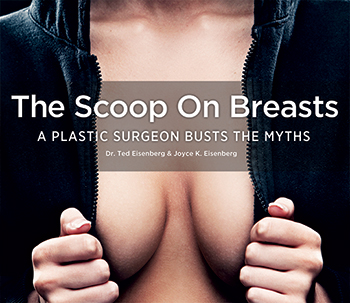Breast Implants Philadelphia
Philadelphia plastic surgeon Dr. Ted Eisenberg has performed more than 7,000 breast augmentations with smooth saline implants and smooth silicone gel implants. He has never used textured breast implants.
How do I know what size breast implants are right for me? At your free consultation for breast augmentation surgery, which patients sometimes refer to as a “boob job,” you’ll see before-and-after photographs of actual patients who started out similar to you in height, weight, frame size and breast volume. It’s like looking into a magic mirror of the future!
You’ll get to vote – “too big,” too small” or “just right” and you’ll discover that you’re consistent on the number of cubic centimeters (ccs) you like. Every photo notes the size of the breast implants Dr. Eisenberg used and he’ll know exactly what size saline or silicone gel implants to order, which will give you the look you want. Read recent patient reviews here.
Click the arrows to expand each answer:
Should I choose saline or silicone breast implants? ▼
How will I choose my breast implant size? ▼
Am I too old for breast implants? ▼
After breast augmentation: When can I sleep on my side? ▼
Do breast implants need to be replaced every 10 years? ▼
Changing breast implant size: What's involved? ▼
Your Breast Implant Options
You’ll have a choice between saline implants and silicone implants for your breast augmentation surgery. Both have a silicone outer shell. Saline implants are filled with sterile saline (salt water); silicone implants are filled with silicone gel.
A breast implant shell can be smooth or textured. Dr. Ted Eisenberg has performed more than 7,000 breast augmentation surgeries with smooth saline implants or smooth silicone implants. He has never used textured breast implants.
Both types of implants come in different sizes and profiles – low (moderate), medium (moderate plus), and high profile. This refers to the implant’s width and forward projection.
Availability: Silicone gel implants are recommended by the FDA and manufacturers for women 22 and older. Saline implants are available to women ages 18 and up.
Implant size: There is a limit to how large an implant can fit behind the chest muscle, and it’s dependent on the width of each breast. A saline implant acts like a tissue expander, which means a woman can sometimes get a slightly larger size than she could with a silicone gel implant.
Incision size: A saline implant, which comes empty, can be folded and placed through a smaller incision. It’s filled after placement. A silicone gel implant comes prefilled and therefore requires a larger incision.
Implant look and feel: Dr. Eisenberg places smooth saline implants and smooth silicone implants behind the pectoral (chest) muscle, not in front of it, because they look more natural. When they are in this placement (as opposed to in front of the muscle), saline and silicone implants feel similar. In slender women who have very thin skin, less breast tissue, and little or no muscle coverage around the side and underneath their breasts, there’s a higher chance that either implant can be felt in these locations.
Implant rupture: When a saline implant shell breaks, the body safely absorbs the saline (salt water) and it’s urinated out. The breast returns to its original size. In Dr. Eisenberg’s experience, the saline deflation rate at 8 years is less than 2%. Read his latest article on this topic, which appeared in the international Aesthetic Plastic Surgery journal.
When a silicone gel implant ruptures, the cohesive gel inside sticks together. Women might not notice a change in breast size. In 2020, implant manufacturers Allergan and Sientra reported a 10-year silicone rupture rate of ≈10%, while Mentor Corporation reported its 10-year rate at approximately 24%, of which 75% were silent. To check silicone gel implants for rupture, the FDA and manufacturers currently recommend that you get an MRI 3 years after surgery and every 2 years thereafter. This might not be covered by health insurance.
In the September 2022 issue of the Aesthetic Plastic Surgery journal, Dr. Eisenberg details the advantages that saline implants offer to both the patient and the surgeon. Read “The Underappreciated Saline Breast Implant” here.
What Breast Implants Can Accomplish
The women who come into our Philadelphia plastic surgery office for breast implants are tell us that they want to feel confident in a bathing suit, to fit into their clothes better, and to feel as good about themselves on the outside as they do on the inside. They want more breast volume so they can stop being self-conscious about their underdeveloped breasts, regain their pre-pregnancy bustline, or restore their breast shape after significant weight loss.
In addition to creating more breast volume, breast implants can address other concerns:
Uneven Breasts: It’s not uncommon for a woman’s breasts to be different in size. When we talk about breast asymmetry, we are talking about a woman whose breasts differ in size by a half-cup or more. Breasts can be made closer in size by enlarging them with breast implants of different sizes, augmenting the smaller breast, or reducing the bigger breast. Dr. Eisenberg has operated on women whose breasts varied by as much as two cup sizes and was able to make a significant improvement.
Tuberous Breasts: Many women who come in for breast implants have a concern about this congenital condition in which the breast might have a combination of a tubular appearance, a lack of skin under the nipple, and/or an inframammary crease that’s higher than usual. While plastic surgery websites and Internet forums describe a complicated approach to correcting tuberous breasts using silicone implants, Dr. Eisenberg has achieved an equally aesthetic result by using saline breast implants in a simpler, safer, one-stage procedure. In the Asymmetry Photo Gallery, almost every woman had some degree of tuberous breasts; they all received saline implants.
Mildly Sagging Breasts: If your breasts are mildly droopy, a saline or silicone gel implant placed behind the pectoral muscle might help create the illusion of perkiness. That’s because as the implant fills out the top of the breast, it also fills out the bottom, making it look as if the nipple has moved higher. It hasn’t. A silicone gel implant placed in front of the pectoral muscle might create the same illusion.
If your breasts are moderately to severely droopy and you get breast implants, it could look as if you have four breasts, with the breast implants up high and your natural breasts down low. A breast lift (mastopexy), with or without implants, would be a better choice; it would restore the breasts to a more youthful look by repositioning the nipples at a higher position and removing excess skin. Read more about Dr. Eisenberg’s groundbreaking I.D.E.A.L. Breast Lift technique.
“Why didn’t I do this sooner? I used to think my very flat chest was just me. But I found a whole new me and finally feel like a woman. I should wear a T-shirt that says, “I waited 58 years for these, and thanks to Dr. Eisenberg I have them.”
– Kathy
Cost of Breast Implants
Dr. Eisenberg’s price is all-inclusive. It includes his surgical fee, hospital and anesthesia costs, smooth breast implants, laboratory tests, and all postoperative visits – usually at 1 week, 3 weeks, 3 months and 9 months. Silicone gel implants cost $1000 more than saline breast implants; that’s because they are more expensive for the manufacturers to produce. When you call our office, we’ll discuss pricing and financing options with you; we work with three reputable companies that are very accommodating to our patients with favorable approvals, quick processing, and minimal red tape.
Breast Implant Surgery
Breast implant placement: Dr. Eisenberg places smooth saline implants and smooth silicone implants behind the pectoral (chest) muscle, not in front of it, because they look more natural. That’s because the muscle blunts the part of the breast implant that peeks out of a tank top, bra or bathing suit. There is also less chance of seeing or feeling the rim of the implant.
The breast implant incision: Dr. Eisenberg will insert your breast implants through an incision under the breast near the crease (the inframammary fold), which will be fairly well hidden. There are fewer vital structures to go through, unlike an underarm incision, which may involve blood vessels and nerves to the arm, and an incision through the nipple, which could interfere with milk ducts and healthy breast tissue.
The day of surgery: Your procedure will be done in the safety of the operating room at Nazareth Hospital, one of the region’s top facilities, with sensitive and competent registered nurses and certified anesthesiologists. On the day of surgery, your support person can stay with you until you are transferred to the operating room. That means he or she can be by your side when you meet the anesthesiologist and when Dr. Eisenberg marks the incision site, takes pictures for you and your records, and reviews your postoperative medications and diet. Then you’ll have to say goodbye – or ta-ta!
Dr. Eisenberg has developed a medication protocol to minimize post-operative nausea and vomiting during breast implant and breast lift surgery.
Breast implant surgery takes less than one hour. After surgery, you will be cared for in the recovery room by compassionate nurses until you are ready to go home later the same day. You must arrange for someone to drive you home.
Recovery After Breast Implant Surgery
The first three days after surgery, women who have had children commonly say they feel like they did when their breasts were fully engorged with milk after childbirth. Women who have not had children describe the feeling as some tightness, burning or pressure. Dr. Eisenberg will prescribe medications to make you more comfortable during this period. The discomfort usually starts to ease up on the fourth day after surgery. More than 90 percent of the patients are back to work in an office setting on the fifth day.
- Three-quarters of our patients report no nausea and vomiting from the day of surgery on; the rest report minimal symptoms.
- You can take a shower the day after surgery.
- By the third day, many women are able to comfortably lift their children; they can also drive a car if they are not taking narcotics.
- Getting back to the gym: Patients can generally return to aerobics in three weeks and upper body weightlifting in six weeks.
- Your first postoperative visit is usually within a week. Your stitches are dissolvable, so there are no stitches to remove at this visit — or ever. There are no drains to be removed either; they are never used.
- It may take between three and nine months for your augmented breasts to achieve their final shape, so we recommend that women wait at least eight weeks before making a major investment in new bras.
After Breast Augmentation Surgery
Will I be able to breastfeed after I get breast implants?
In most cases, a breast augmentation will not interfere with breastfeeding. That’s because the milk ducts are generally not disturbed during the procedure when implants are placed through an incision under the breast. However, not all women are naturally able to breastfeed, whether or not they have cosmetic breast surgery.
Do breast implants have to be replaced every 10 years?
Breast implants only need to be replaced if they deflate (saline implants) or rupture (silicone implants), and they’re not fragile. Through the years, manufacturers have increased the strength of the implant shell; in Dr. Eisenberg’s experience, only about 3 percent or less of implants break. He recently removed saline implants from a woman who wanted to go bigger after 23 years, and her implants looked the same as the day he put them in.
Do breast implants get in the way of reading a mammogram?
With over 300,000 women having breast augmentations each year, most radiologists are likely to have experience evaluating breasts with implants. When you schedule your mammogram, it’s important to let the facility know that you have breast implants. To maximize the amount of breast tissue that can be seen, the technician will gently displace (push up) the implants and will take extra views of each breast.
Because Dr. Eisenberg places breast implants behind the chest muscle, the implant interferes less with your mammogram. Likewise, the placement does not interfere with a manual breast exam by you or your gynecologist.




 CLICK HERE TO BUY
CLICK HERE TO BUY








